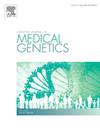Clinical variability in individuals with ATR-X syndrome in the Netherlands
IF 1.7
4区 医学
Q3 GENETICS & HEREDITY
引用次数: 0
Abstract
Background
The Alpha Thalassemia mental Retardation syndrome, X-linked (ATR-X syndrome, MIM: 301040) is a rare genetic disorder characterized by alpha thalassemia, intellectual disability, peculier facial characteristics and genital abnormalities. Detailed information regarding the clinical phenotype is lacking.
Aims
Detailed descriptions of the clinical phenotype are rare. The aim of this study was to describe the clinical phenotype of ATR-X syndrome.
Methods
Data was collected through questionnaires, interviews, physical examination and the study of medical records.
Results
Twenty-two individuals, aged 2–68 years old, were included. Three individuals were deceased at the time of the study. The individuals had a variable degree of intellectual disability. Alpha thalassemia was found in 30 % and genital anomalies in 70 % of the individuals. First clinical signs of the syndrome were most frequently feeding problems, started in the neonatal period in the majority. Other main reported health problems were reflux (59 %), constipation (72 %), periods of anorexia and adipsia (45 %), heart defects (28 %), epilepsy (33 %), scoliosis/kyphosis (48 %), visual impairment (61 %) and hearing loss (38 %). Behavioral problems (86 %) and sleeping problems (64 %) also occurred frequently.
Conclusion
We report on the largest cohort of clinically studied individuals with ATR-X syndrome, including the eldest individuals, reported to date. Clinical knowledge is essential to improve care and to evaluate future therapies for this group.
荷兰ATR-X综合征患者的临床变异性
背景:阿尔法地中海贫血精神发育迟滞综合征,x连锁(ATR-X综合征,MIM: 301040)是一种罕见的遗传性疾病,以阿尔法地中海贫血、智力残疾、特殊面部特征和生殖器异常为特征。缺乏有关临床表型的详细信息。目的:临床表型的详细描述是罕见的。本研究的目的是描述ATR-X综合征的临床表型。方法:采用问卷调查、访谈、体格检查和病历研究等方法收集资料。结果:纳入22人,年龄2-68岁。在研究期间,已有3人死亡。这些人有不同程度的智力残疾。30%的人发现阿尔法地中海贫血,70%的人发现生殖器异常。该综合征的首要临床症状是最常见的喂养问题,以新生儿期开始为主。其他报告的主要健康问题是反流(59%)、便秘(72%)、厌食和厌食(45%)、心脏缺陷(28%)、癫痫(33%)、脊柱侧凸/后凸(48%)、视力障碍(61%)和听力损失(38%)。行为问题(86%)和睡眠问题(64%)也经常发生。结论:我们报道了迄今为止报道的最大的ATR-X综合征临床研究个体队列,包括最年长的个体。临床知识对于改善护理和评估该群体的未来治疗至关重要。
本文章由计算机程序翻译,如有差异,请以英文原文为准。
求助全文
约1分钟内获得全文
求助全文
来源期刊
CiteScore
4.10
自引率
0.00%
发文量
193
审稿时长
66 days
期刊介绍:
The European Journal of Medical Genetics (EJMG) is a peer-reviewed journal that publishes articles in English on various aspects of human and medical genetics and of the genetics of experimental models.
Original clinical and experimental research articles, short clinical reports, review articles and letters to the editor are welcome on topics such as :
• Dysmorphology and syndrome delineation
• Molecular genetics and molecular cytogenetics of inherited disorders
• Clinical applications of genomics and nextgen sequencing technologies
• Syndromal cancer genetics
• Behavioral genetics
• Community genetics
• Fetal pathology and prenatal diagnosis
• Genetic counseling.

 求助内容:
求助内容: 应助结果提醒方式:
应助结果提醒方式:


